DPS 5-05: More Images of Africa and their Stories & Top Reasons to buy a D-SLR
We've gotten lots of positive feedback from readers that they enjoy reading about and learning from images and the stories behind them. So in this issue we're showcasing some images from our May photo safari to Botswana. Plus we'll list the top reasons to buy a D-SLR instead of a point and shoot--something you can use the next time you're asked why you're carrying such a large camera!
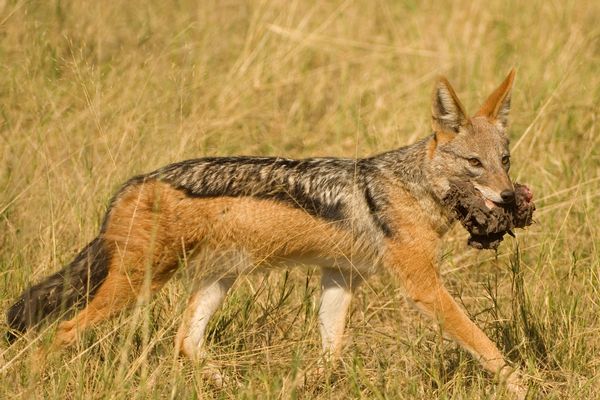
Nikon D2X, f4 @ 1/3200s
Copyright David Cardinal
Jackal with Buffalo meat -- Awareness:
We were happily snapping away as a pride of lions feasted on a Cape Buffalo they had killed. It would have been easy to leave it at that, but some of the most interesting action around a kill often comes from the secondary predators and scavengers. In this case some of the lions would drag bits of the carcass off to eat and a Black-backed Jackal would sneak in and try to grab any pieces that went astray. The Jackal was understandably shy so Vibration Reduction was very helpful in getting sharp images even from our moving truck.
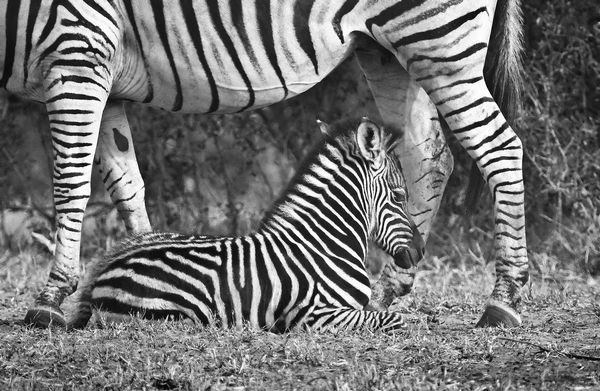
Nikon D2X, f6.7 @ 1/250, + 1/2 EV
Copyright David Cardinal
Creativity -- B&W of Zebra mother and foal
It's easy to focus on portraits of animals or even group shots, but sometimes a shot can be created by thinking about how you'll process it. It was late one morning and the light was very harsh. We were headed back to camp as it was getting hot and the colors were getting washed out by the sun. I noticed this Zebra with her foal and realized that the pattern they made was interesting and that if I converted the image to black and white that the pattern would be accentuated while removing the issue of the harsh light and faded colors.
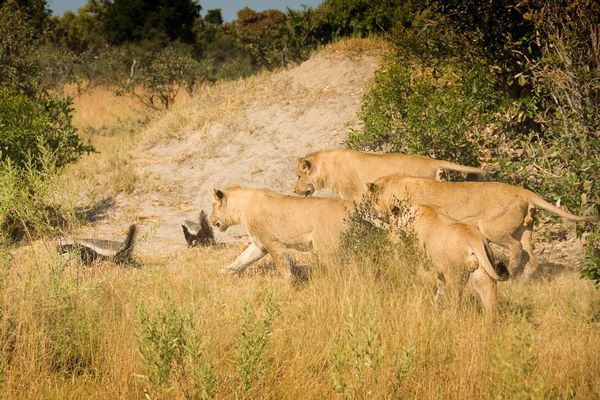
Nikon D2X, f5 @ 1/1600s
Copyright David Cardinal
Patience: Lions + Honey Badgers:
After a great morning of watching a pride of lions interacting with a herd of Buffalo the lions had given up and were looking for a place to sleep. The other truck that had been watching had left and my clients were anxious to know whether it was time to head back to camp. But until the lions are really asleep you never know what can happen, so we stayed a few more minutes. Sure enough, the young males picked a shady area for a nap that was already occupied by a mother and young Honey Badger! The result was quite a dust up (complete with the smell of the Honey Badgers releasing their scent) as the lions tried to catch the smaller creatures. Honey Badgers are renowned for their ferocity and were quick to turn on the lions and work to fight them off. At one point one of the lions got a paw on the young badger, but its subsequent yelp attracted the attention of its mom who wheeled around and nipped at the lion until it backed off.
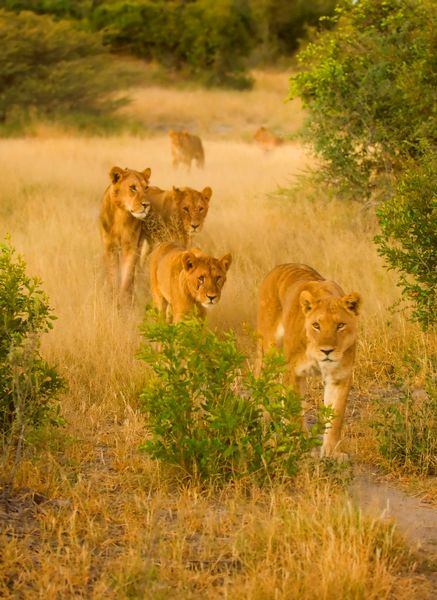
Nikon D2X, f2.8 @ 1/30s
Copyright David Cardinal
Anticipation: (Lions stalking at sunset)
Chasing animals to get a shot is usually not very productive and can be quite stressful to the animals. A much better approach is to anticipate where the animal is headed and then find a good place to wait and let the animals come towards you. To make this work requires a long enough lens so that the animals appear to be near you but you aren't actually in their way. It also requires a good local guide or expertise in knowing how the animals are reacting to ensure that you aren't changing their direction or behavior by being nearby. One of the emotional highlights of our safari was when an entire pride of lions starting to hunt streamed by our truck. This shot captured 6 of them as they walked by.
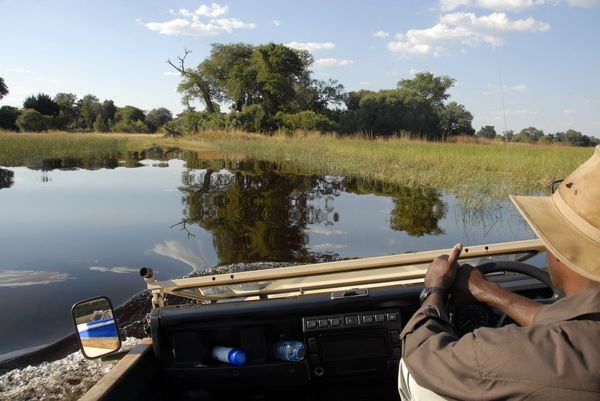
Nikon D200, f9.5 @ 1/320s, 18-200mm @ 18mm
Copyright David Cardinal
Truck in Flood Water -- Experiences
Share your experiences, not just what you see. Especially if you're creating a slideshow for friends you'll be happy to have some images which help you re-enact your most memorable moments. In this case, each day we stayed in the Okavango Delta the water was a little higher as the annual floods continued to head southward. As the Fall wears on, eventually some of the roads are too flooded for even the amazing Land Rovers and those areas require boats to visit.
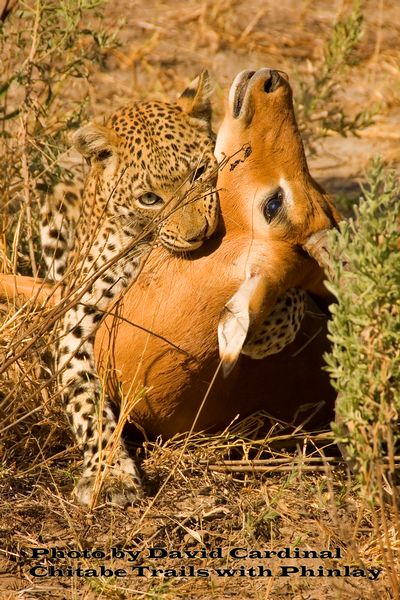
Nikon D200, f9.5 @ 1/400s
Copyright David Cardinal
Calm (Leopard with Impala):
Sometimes you just get lucky. On the first day of our safari (in fact the first morning) we were tracking a leopard when she took off towards a group of Impala. We don't interere with predators when they're hunting so after waiting a little we proceeded forward to find that she had just brought down an Impala. Needless to say we were all quite excited at the action and a little in awe of the scene we were witnessing. Photographically the light was still good, the subject was clearly in front of us, so technically they were easy images to make. But staying calm allowed me to think to go vertical (& remind the clients to do the same) which greatly improved the quality of the image.
Cardinal Photo Safaris Update: |
|
Alaska Grizzly Bear & Puffin trips, July 2009:
|
|
Africa : Botswana, November 14-26, 2009
|
|
|
Burma and Cambodia, December 2009:We're excited about returning to Burma (Myanmar) and Cambodia. The main trip will be divided between the temple areas in Cambodia (especially the Angkor temple complex including Angkor Wat) and Burma (including historic Mandalay and the plain of temples at Bagan, as well as the capital Yangon, nee Rangoon). Learn more. We'll also have an optional post-trip extension to Laos, featuring Vientiane & Luang Prabang. We just finished a second very successful 2007 trip (and about to head off for our 2008 trip) and are ready with what we think will be an even better itinerary for next December, 2009. Learn more about the trip now. |
South Texas Birds, April 12-18, 2009
|
|
|
|
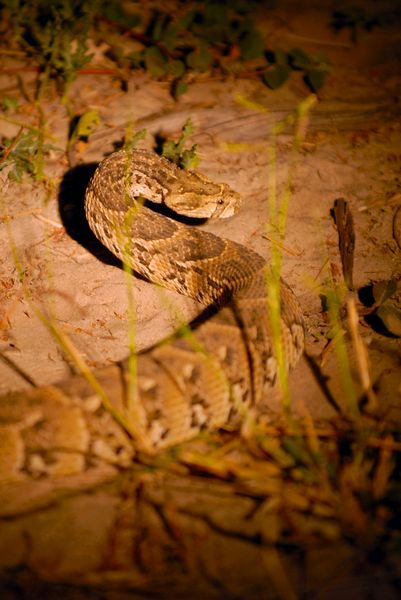
Nikon D200, f8 @ 1/160s, 70-200mm @ 200mm
Copyright David Cardinal
Puff Adder -- Luck
Usually Puff Adders scoot away when you find them (which is of course generally a good thing as they are one of the world's most poisonous snakes!) but their shyness makes them hard to photograph in an interesting pose. This one saw the shadow of our truck mirror and thought it was a threat so it coiled in a state of warning--provding us with a great and unexpected pose.
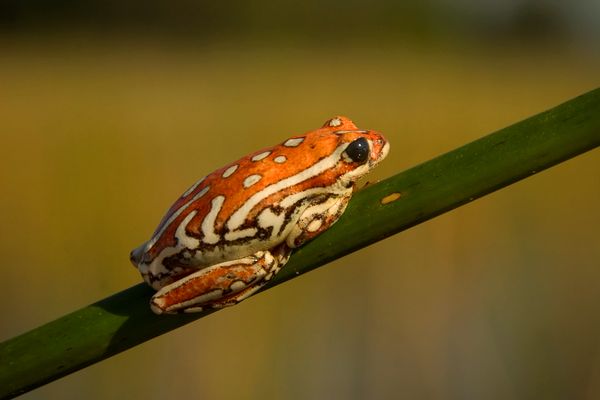
Nikon D200, f11 @ 1/750s, -1 EV
Copyright David Cardinal
Painted Reed Frog -- "MFD"
Know the Minimum Focusing Distances (MFDs) of your lenses. I didn't have the time to put a macro lens on the camera when we found this tiny but beautiful frog when we were out in Mokoros (dugout canoes) in the Okavango Delta. But I knew that I could get a pretty good reproduction ratio by zooming in to 200mm and focusing my 18-200 at only a few inches--the MFD of my lens. VR was also crucial, as the reed was swaying, the mokoro was moving and I was holding the camera with one hand while trying to steady the reed with the other.
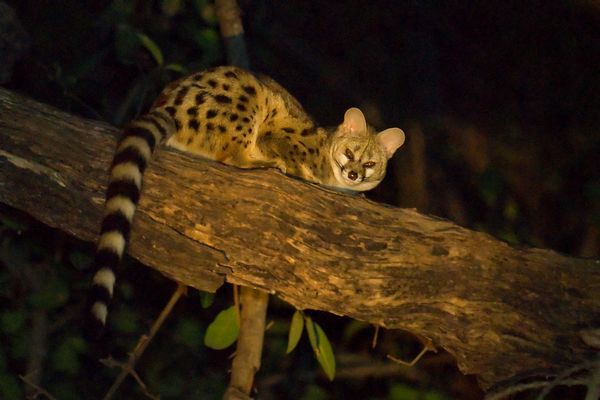
Nikon D200, f2.8 @ 1/60s, -1/2 EV
Copyright David Cardinal
Genet -- Be prepared
My camera is always around when I'm at camp. When one of our guides came into the lounge area late one night to ask if anyone wanted to photograph a Genet I was quickly able to put my 70-200f/2.8 & SB-800 on my D200 (I've found I like the low light noise performance of the D200 better than my D2X) and go out and get a shot of this very shy and elusive nocturnal animal.
SAFARI Update: We've just announced our Africa trips for 2008. Be among the first to sign-up and experience the photo adventure of a lifetime!
Top Reasons to Buy a D-SLR
Like many of you I've gotten used to being asked why I'm carrying "such a large camera." Of course, once the curious onlooker realizes I know something about photography the next question is invariably, "Gee, I really like my [tiny point and shoot] but I'm having trouble photographing [kids / sports / animals]. What do I need to do?" Of course, aside from a few technique tips their real problem may be that they need a D-SLR. So the next time someone asks you what camera they should buy or why you're carrying that brick, you can refer them to this list of top reasons to purchase a D-SLR as your next camera:
- Speed: It takes the picture when you want it to: D-SLR users are accustomed to worrying about a few milliseconds of shutter lag. But whether it lags 15 or 50ms, your D-SLR is much quicker than the comparitively glacial shutter lags of point and shoots, often over a second if the camera needs to meter, focus and heat up the flash. The difference can be whether or not you capture the expression or action you're looking for.
- Action: You can upgrade to faster lenses for sports, kids, or wildlife: With the supplied kit lens, most D-SLRs don't function that much differently than a good point and shoot for well lit static subjects. But as light fades or the action gets faster, the D-SLR owner has the option to purchase better glass, often one to two stops faster, and seriously upgrade their ability to capture action.
- Image Quality: Larger sensors mean less noise: Whatever you think of the full-frame debate among the owners of pro cameras, there is no question that D-SLR cameras achieve lower noise than their point and shoot cousins. This means better picture quality, especially as you enlarge your photographs. Even with noise reduction software the difference is noticeable in enlargements.
- Ruggedness: Not a hammer, but you can bump it around: There is nothing more frustrating than getting to your destination and finding your camera broken. D-SLRs are built more solidly than point and shoots, and are designed to survive harsher use and last longer.
- Flash: Off-camera flash is essential for professional portrait results: Most point and shoots have very limited flash capability--typically a tiny flash located right near the lens. This makes fighting red-eye very difficult and of course those cameras also don't allow for the flexible multiple flash systems that D-SLRs allow. For anyone who really needs professional results using flash, a D-SLR along with a pro level flash system is the way to go.
- Wide-Angle: Sweeping Landscapes and Artistic Perspectives: Except for a very few of the newest "super-zoom" point and shoots most of them can't zoom out very wide. Sometimes this just means taking a few extra steps back to re-frame an image, but other times it prevents you from getting the perspective you want.
- Manual Operation, a Learning Tool: Whether you're a purist or just want to learn photography, the controls on most D-SLRs are very conducive to manual metering and focusing. Some point and shoots do allow manual control, but it is awkward and many others don't allow any manual settings at all.
- Wildlife, Telephoto Lenses for Special Situations: Most photographers won't ever buy a lot of "big glass", but for wildlife and many sports it's great to be able to rent or buy a long lens. Point and shoots often have telephoto adapters, but they don't provide the same image quality. A few of the new "super-zoom" point and shoots are starting to equal the telephoto range of larger lenses (400mm and even more), but they are the exception rather than the rule.
Do you have a favorite reason to own a D-SLR? Let us know in our Photo Tools forum.
Online Forums Update
Poll results are coming in from our subscribers. We asked whether they wished that camera companies spent more time getting their products ready for market--adding a formal beta testing program. Overwhelmingly (by a margin of 70% to 30%) our forum members would rather wait longer to get their products and allow for a beta test rather than see products rushed to market. Let us know your opinion.
 | Professional Photoshop 5 by Dan Margulis is now available, discounted to $38 at Amazon. Whether or not you've read previous versions of Dan's signature work the new edition has a huge amount of new and updated material and is worth buying. |
Search our Sites:






